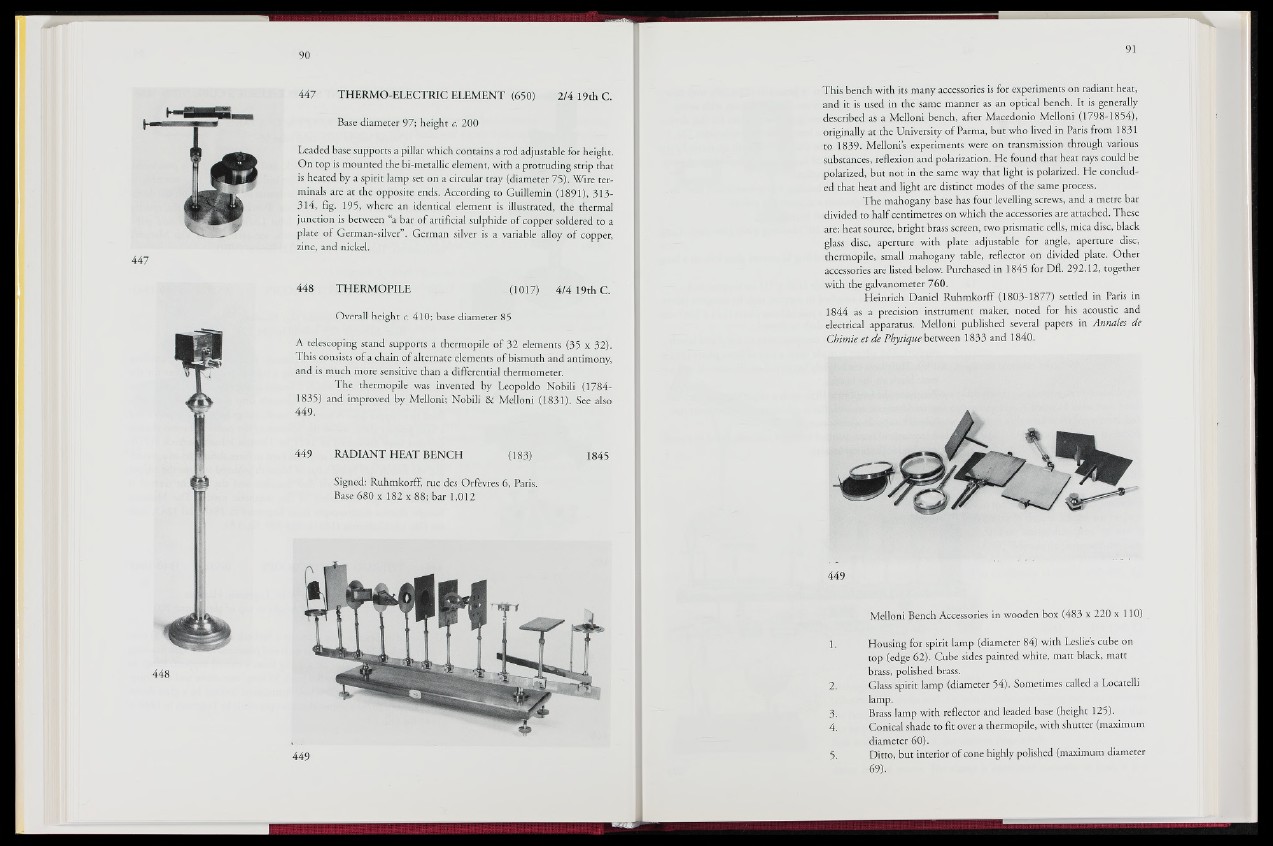
447 THERMO-ELECTRIC ELEMENT (650) 2/4 19th C.
Base diameter 97; height c. 200
Leaded base supports a pillar which contains a rod adjustable for height.
On top is mounted the bi-metallic element, with a protruding strip that
is heated by a spirit lamp set on a circular tray (diameter 75). Wire terminals
are at the opposite ends. According to Guillemin (1891), 313-
314, fig. 195, where an identical element is illustrated, the thermal
junction is between “a bar of artificial sulphide of copper soldered to a
plate of German-silver”. German silver is a variable alloy of copper,
zinc, and nickel.
448 THERMOPILE -(101?) 4/4 19th C.
Overall height c. 410; base diameter 85
A telescoping stand supports a thermopile of 32 elements (35 x 32).
This consists of a chain of alternate elements of bismuth and antimony,
and is much more sensitive than a differential thermometer.
The thermopile was invented by Leopoldo Nobili (1784-
1835) and improved by Milloni; Nobili & MeUonf'(1831). See also
449.
449 RADIANT HEAT BENCH (183) 1845
Signed: Ruhmkorff, rue des Orfèvres 6, Paris.
Base 680 x 182 x 88; bar 1,012
This bench with its many accessories is for experiments on radiant heat,
and it is used in the same manner as an optical bench. It is generally
described as a Melloni bench, after Macedonio Melloni (1798-1854),
originally at the University of Parma, but who lived in Paris from 1831
to 1839. Melloni’s experiments were on transmission through various
substances, reflexion and polarization. He found that heat rays could be
polarized, but not in the same way that light is polarized. He concluded
that heat and light are distinct modes of the same process.
The mahogany base has four levelling screws, and a metre bar
divided to half centimetres on which the accessories are attached. These
are: heat source, bright brass screen, two prismatic cells, mica disc, black
glass disc, aperture with plate adjustable for angle, aperture disc,
thermopile, small mahogany table, reflector on divided plate. Other
accessories are listed below. Purchased in 1845 for Dfl. 292.12, together
with the galvanometer 760.
Heinrich Daniel Ruhmkorff (1 8 0 3 - ll« | settled in Paris in
,1844 as a precision instrument maker, noted for his acoustic and
electrical apparatus. Melloni jmblished several papers in Annales de
Chimie et de Physique between 1833 and 1840.
449
Melloni Bench Accessories in wooden box (483 x 220 x 110)
1. Housing for spirit lamp (diameter 84) with Leslie’s cube on
top (edge 62). Cube sides painted white, matt black, matt
brass, polished brass.
2. Glass spirit lamp (diameter 5ffl Sometimes called a Locatelli
• lamp.
3. Brass lamptwith reflector and leaded base (height 125).
4. Conical shade to fit over a thermopile, with shutter (maximum
diameter 60).
5. Ditto, but interior of cone highly polished (maximum diameter
69).